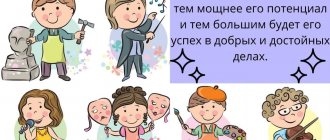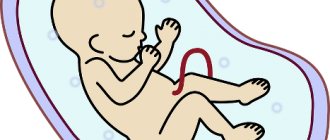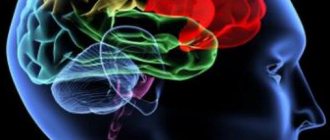Human cognitive development
The cognitive system describes all stages of the human learning process in the best possible way. How does thought processes develop from childhood to adulthood? Let's try to understand this in more detail, referring to the concepts of Bruner, Piaget and Wallon.
According to Bruner's concept (1966), our knowledge of the world is, first of all, sensitive and motor in nature. This means that nothing can be included in thought without first passing through our senses, especially through motor activity. Therefore, we can say that the sensorimotor reflection of reality is crucial in childhood. To this display of the world, another method is quickly added - iconic display (when the child internalizes and stores in memory images of real objects perceived by him). During adolescence and adolescence, this world of images gradually gives way to concepts - symbolic representations of objects. The stimulus for such a transition is mainly speech. Bruner pays special attention to the fact that language represents the most important step in the development of cognitive processes. Since language is not only a means of transmitting cultural heritage, but is also a regulator of behavior, because a word can cause or suppress one or another action.
Piaget's concept (1966) suggests that the development of cognitive processes is the result of a person's constant attempts to adapt to changes in the environment. Because external influences force our body either to modify activity structures (if they no longer satisfy the requirements of adaptation), or, if necessary, to develop new structures. What is meant here is that the adaptation is carried out using two mechanisms. Namely:
1. assimilation (in which a person tries to adapt a new situation to existing structures and skills).
2. accommodation (in which old patterns and response techniques are modified in order to adapt them to a new situation)
Swiss psychologist Jean Piaget set himself the task of finding out how a person experiences the real world. He identifies 3 main stages of development of cognitive processes:
1. Sensorimotor stage (formation and development of sensory and motor structures - the first two years of a child’s life)
2. Stage of concrete actions (words increasingly begin to mean specific objects, and actions are gradually internalized - from 2 to 11 years old. This is how thinking develops. At first, this thinking is subjective in nature, at this stage it is egocentric, but despite this it allows the child to manipulate objects, compare them, classify and carry out specific operations on them. And by the age of 10, the child acquires the ability to objectively interpret concrete reality. This ability increases more in the next stage).
3. Stage of formal operations (abstract thinking, also conceptual thinking, develops. According to Piaget, this stage reaches full development by the age of 14-16. Although many studies have shown that only a part of people, approximately 25-50%, can actually think abstractly).
Also, thanks to his research, Piaget identifies each stage with its own substages, or, to put it differently, phases.
So, the sensorimotor stage includes 6 stages:
a) congenital reflexes (1 month of a child’s life) - these are reflexes of sucking, blinking, grasping caused by external stimuli;
b) motor skills (from 1 to 4 months) – here conditioned reflexes are already formed as a result of the interaction of the child and the environment, for example, grasping a bottle with a nipple, etc.;
c) circular reactions (from 4 to 8 months) - the development of coordination between perceptual systems and motor movements, for example, grabbing a rope, causing a rattle to shake, in order to make it rattle;
d) coordination of means and goals (from 8 to 12 months) - the child’s actions are more and more deliberate, aimed at achieving their goal;
e) random discovery of new funds (from 12 to 18 months) - by pulling the tablecloth, you can get objects lying on the table;
f) invention of new means (from 18-24 months) - search for new solutions to achieve goals, getting desired items, solving 2-3-phase problems;
The sensorimotor stage is characterized by the functioning of visual-effective thinking and the formation of visual-figurative thinking.
Qualitative characteristics of thinking
Thinking, like other human cognitive processes, has a number of specific qualities. These qualities are present to varying degrees in different people, and are important to varying degrees in solving different problem situations. Some of these qualities are more significant when solving theoretical problems, while others are more significant when solving practical issues.
Examples of qualities (properties) of thinking:
Quick thinking - the ability to find the right solutions under time pressure
Flexibility of thinking - the ability to change the intended plan of action when the situation changes or the criteria for the right decision change
Depth of thinking - the degree of penetration into the essence of the phenomenon being studied, the ability to identify significant logical connections between the components of the problem
Cognitive approach in psychology
Cognitive psychology allows us to study the human cognitive system, following an external stimulus, obtaining information, processing it, storing it or losing it, then managing the stored information, using it and expressing it.
According to Bruner's concept, our knowledge of the world is primarily of a sensory and motor nature, because nothing can be included in thought without first passing through our senses and motor activity. Jean Piaget concluded that cognitive development is the result of a gradual process that consists of successive stages, and the development of a child's intelligence occurs as a result of a constant search for balance between what the child knows and what he strives to understand.
Cognitive theories of personality consider a person as “understanding and analyzing,” because a person is in a world of information that needs to be understood, evaluated and used. And a person’s action includes 3 components: 1. The action itself. 2. Thoughts. 3.Feelings. Outwardly, actions may be different, while thoughts and feelings may be different. Different people “see” and evaluate the situations in which they act differently. Finding himself in a real situation, a person needs to decide. He makes a choice and commits an action (behaviorists finish analyzing behavior here), but the cognitive part of the action is not yet completed, because the action itself is a source of information that allows you to formulate or change your opinion about yourself or others. It turns out that after a reaction, a person, to one degree or another, carries out a subjective analysis of his behavior, its success, as a result of which conclusions are drawn for the future and the necessary correction.
Psychologist Zimbardo concluded that most negative behavior is explained by situational and interpersonal factors, he says that even good people can commit negative actions in difficult circumstances and situations. Psychologist Ellis, in turn, believes that incorrect human behavior is caused primarily by irrational thoughts that are generated by an “activating situation.” In this case, the situation and conclusions must be analyzed together with the person, since the therapist’s tasks include studying the patient’s thought processes and bringing to his consciousness the irrational moments contained in his thoughts. And developing a more objective perception of events in a person leads him to search for new, already effective solutions. This means that maladaptive forms of behavior will gradually be replaced by new, more effective forms, and as a result, behavior will change.
Psychologist A. Beck pointed out that “how people think determines what they feel and how they act.” From which it is concluded that the goal of cognitive therapy is “to modify dysfunctional beliefs and faulty ways of processing information.” Changes in perception and thinking entail modifications in painful experiences and behavioral responses. Beck calculated and described the phenomenon of “automatic thoughts”, which are associated with the processing of current information; they are involuntary, fleeting, unconscious and directly lead to emotional and behavioral reactions. He also says that in emotional disorders, automatic thoughts are distinguished by a number of specific features, for example, sadness is put in correspondence with thoughts about loss, anger - thoughts about violating some standard, melancholy - thoughts of negative content about oneself, the world, people, the future , fear - thoughts about external danger and the impossibility of coping with it due to one’s own insolvency.
Individuals with mental disorders have certain dysfunctional underlying assumptions that cause them to distort and evaluate current situations and experience negative emotions and maladaptive actions. Basic premises are a system of a person’s deep ideas about himself and the world around him, this is a unique philosophy of life of a person, in which all his life experiences are recorded (children’s impressions and family influences play a special role here). The psychotherapist needs to help the patient present his ideas in the form of hypotheses and, together with the patient, search for alternatives.
Scientific background:
1) criticism of behaviorism and the revival of interest in the topic of consciousness in the United States since the 50s of the twentieth century;
2) the influence of Gestalt psychology - the adoption of the active role of the subject, interest in the problem of consciousness;
3) the teachings of J. Piaget, who conducted a number of significant studies on child psychology from the standpoint of studying the stages of a child’s cognitive development;
4) changing the scientific paradigm in physics - abandoning the idea of absolute objectivity and recognizing the active role of the subject in the cognitive process.
George Kelly's Cognitive Approach
George Kelly is one of the founders of this trend. He believes that every person is an explorer who strives to understand, interpret, anticipate and control the world of his personal experiences. And all conclusions are drawn on the basis of one’s past experience and assumptions made about the future. He points out that although objective reality exists, different people still perceive it differently, because any event can be viewed from different angles, and people, in turn, are given a wide choice of opportunities in interpreting the inner world of experiences or the outer world of practical events. People are primarily focused on the future rather than on past or present events in their lives. The point of view on life is transient, it is rarely the same as it was yesterday or will be tomorrow. People also have the ability to actively form an understanding of their environment, rather than simply react passively to it. Kelly believed that “we perceive the world through clear systems or models called constructs. A personality construct is an idea or thought that a person uses to understand or interpret, explain or predict his or her experience. It represents a stable way in which a person comprehends some aspects of reality in terms of similarity and contrast.” To form a construct, 3 elements (phenomenon or object) are needed: two of them must be similar to each other, and the third element must be different from these two. Therefore, it should be assumed that all personality constructs are bipolar and dichotomous, a person’s thinking is aware of life experiences in terms of black and white, and not shades of gray. All constructs have two opposite poles: the similarity pole reflects how two objects are similar, and the contrast pole shows how these objects are opposite to the third element. Examples of personal constructs can be “smart - stupid”, “male - female”, “evil - good”.
Kelly also distinguishes between permeable and impenetrable constructs. A permeable construct allows into its range elements of applicability that have not yet been interpreted within its boundaries; it is open to the explanation of new phenomena. In turn, the impenetrable construct remains closed to the interpretation of new experience. Kelly proposed that constructs can be classified:
1. Anticipatory classification constructs (what is included in one classification is excluded by another, preventing the phenomenon being assessed from being seen in a new light).
2. Constellatory constructs (when a phenomenon belongs to a certain category of one construct, its other characteristics. That is, if we attribute a person to a given category, then we endow him with all the corresponding characteristics).
3. Assumption constructs (these constructs can change, they accept alternative points of view and are open to new experiences).
Personal constructs are: a) comprehensive constructs that include a wide range of phenomena; b) private constructs - include a narrow range of phenomena and possibilities; c) basic constructs that regulate basic human activity; d) peripheral constructs - can change without significantly changing the main structure.
Each person perceives reality using their own models or constructs necessary to create a consistent picture of the world. If a construct helps accurately predict events, then a person is likely to retain it. Conversely, if the prediction is not confirmed, then the construct will most likely be subject to revision or may be excluded altogether. Each person has such a unique constructive system (personality). People differ from each other in how they interpret events; absolutely identical people, even if they are twins, interpret events differently. Each person understands reality based on his personal unique construct. And people look at the present in such a way as to foresee the future using a unique system of their personal constructs, accordingly, a person’s behavior is determined by how he predicts future events.
And naturally, Kelly believed that each person’s construct system is unique, and people disagree because everyone operates within their own construct system. The difference also lies in how people organize their constructs. And they, in turn, are organized into a pyramidal structure so that some of them are either subordinate or in a subordinate position relative to other parts of the system. And all this is very individual, since constructs in one person’s system do not necessarily occupy the same position in another person’s system. Kelly suggested that if we know how a person organized his constructs, then we can correctly judge his behavior. Those. to know personality is to know how a person interprets his personal experiences. “Personality is understood as an organizational system of more or less important constructs that a person uses to interpret the world of experiences and anticipate future events.”
Practical use:
1) Cognitive psychotherapy is a psychotherapeutic method developed by A.T. Bekomi based on developing optimal assessment and self-assessment techniques. The basis of this method is the assertion that cognition is the main determinant of the emergence of certain emotions, which in turn determine the meaning of holistic behavior. At the same time, the occurrence of mental disorders (initially depressive states) was explained primarily due to incorrectly constructed self-knowledge. The procedure of this method includes three stages. At the stage of logical analysis, the patient receives criteria for detecting errors of judgment that arise in affectogenic situations; at the stage of empirical analysis - works out techniques for correlating elements of an objective situation; at the stage of pragmatic analysis - builds optimal awareness of one’s own actions.
2) Rational Emotive Behavior Therapy (REBT) is an active-directive, educational, structured, multimodal approach to psychotherapy and psychological counseling, focused on the problem, created by A. Ellis in 1955 and considering as the main cause of mental disorders are erroneous, irrational cognitive attitudes (beliefs, beliefs, ideas, assumptions, etc.), and not the past experience of the individual (unlike psychoanalysis).
Such cognitions in REBT terms are called “irrational beliefs” (sometimes “irrational beliefs”) and the main goal of therapy is to eliminate them.
Cognitive psychology is actively developing and is far from complete, has all the signs of a scientific school and has become part of the mainstream of psychological thought.
Thinking and intelligence
Intelligence
- the totality of a person’s mental abilities that ensure the success of his cognitive activity.
In a broad sense, this term is understood as the totality of all cognitive functions of an individual (perception, memory, imagination, thinking), and in a narrow sense - his mental abilities.
In psychology there is a concept of the structure of intelligence
However, the understanding of this structure varies widely depending on the views of a particular psychologist.
For example, the famous scientist R. Cattell identified two sides in the structure of intelligence: dynamic, or fluid ( “fluid”
), and static or crystallized (
“crystallized”
).
According to his concept, fluid intelligence manifests itself in tasks whose solution requires quick and flexible adaptation to a new situation. It depends more on the person's genotype. Crystallized intelligence is more dependent on the social environment, and is manifested when solving problems that require relevant skills and experience.
4 pp., 1578 words
Thinking and intelligence Definition of thinking
... of a transformative and educational nature. Basic types of thinking. Theoretical conceptual thinking is such thinking, using which a person, in the process of solving a problem, turns to... testing hypotheses. All this makes practical thinking in a certain respect more complex than theoretical thinking. Intelligence is a relatively stable structure namely...
You can use other models of the structure of intelligence, for example, highlighting the following components in it:
·Ability to learn (quickly acquire new knowledge, skills and abilities);
·Ability to successfully operate with abstract symbols and concepts;
·Ability to solve practical problems and problem situations.
·The amount of available long-term and RAM memory.
Accordingly, intelligence tests include several groups of tasks. These are tests that reveal the amount of knowledge in a certain area, tests that evaluate a person’s intellectual development in connection with his biological age, tests that determine a person’s ability to solve problem situations and intellectual tasks. In addition, there are special intelligence tests, for example, abstract-logical or spatial thinking, verbal intelligence, etc. The most famous intelligence tests include:
Stanford-Binet test
: assesses the child's intellectual development.
Wechsler test:
assesses the verbal and nonverbal components of intelligence.
Raven's test:
nonverbal intelligence.
Eysenck test (IQ)
– determines the general level of intelligence development
When studying intelligence in psychology, there are two approaches: intellectual abilities are innate or intellectual abilities develop in the process of individual development, as well as their intermediate version.
New stage of research
American neurophysiologist, physician and psychologist Karl Pribram, collaborating with the famous researcher in behavioral psychology Karl Lashley, developed a holographic model of the functioning of the human psyche, which led to a unique discovery. Memory is not concentrated in separate areas of the brain, but is distributed across all parts. This discovery revolutionized cognitive psychology, since it was previously believed that it was the middle lobes of the brain that were responsible for the perception and storage of information. Pribram's theory and experimental results are not fully accepted, but are indirectly confirmed by most subsequent experiments.











